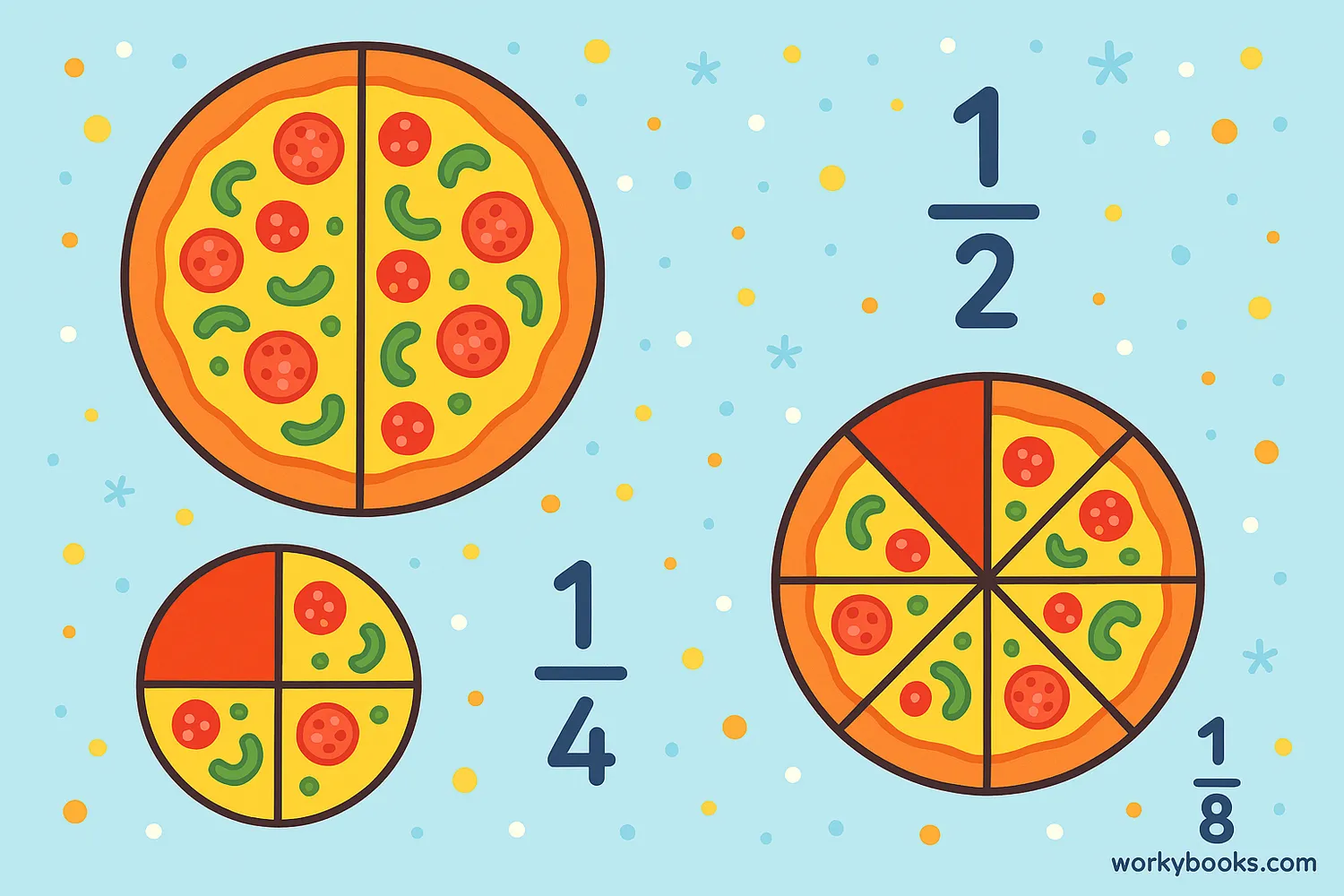Fraction Rules - Definition, Examples, Quiz, FAQ, Trivia
Learn fraction rules with easy explanations, visual examples, and practice activities
What are Fractions?

A fraction represents parts of a whole. The top number is called the numerator and tells us how many parts we have. The bottom number is called the denominator and tells us how many equal parts the whole is divided into.
For example, in the fraction
Fractions are everywhere in our daily lives: when we share pizza, measure ingredients for cooking, or tell time ("quarter past three" means 15 minutes past 3 o'clock).
Key Concept
Fractions represent equal parts of a whole. The numerator counts the parts, and the denominator tells how many equal parts make the whole.
Adding Fractions
To add fractions, they must have the same denominator. If they don't, we need to find a common denominator first.
Addition Rule
When denominators are the same, add the numerators and keep the denominator.
Example: Add
Step 1: Check denominators → Both are 4
Step 2: Add numerators → 1 + 2 = 3
Step 3: Keep denominator → 4
Result:
When denominators are different, find a common denominator first. For example, to add
Remember
Always simplify your answer to lowest terms. For example,
Subtracting Fractions
Subtracting fractions follows similar rules to adding fractions. The denominators must be the same.
Subtraction Rule
When denominators are the same, subtract the numerators and keep the denominator.
Example: Subtract
Step 1: Check denominators → Both are 4
Step 2: Subtract numerators → 3 - 1 = 2
Step 3: Keep denominator → 4
Result:
When denominators are different, find a common denominator first, just like with addition.
Important Note
You cannot subtract a larger numerator from a smaller numerator without regrouping when working with mixed numbers.
Multiplying Fractions
Multiplying fractions is straightforward! Unlike addition and subtraction, you don't need a common denominator.
Multiplication Rule
Multiply the numerators together and the denominators together.
Example: Multiply
Step 1: Multiply numerators → 1 × 3 = 3
Step 2: Multiply denominators → 2 × 4 = 8
Result:
You can simplify before multiplying by canceling common factors between numerators and denominators. For example,
Multiplication Tip
When multiplying a fraction by a whole number, convert the whole number to a fraction by putting it over 1. For example, 3 ×
Dividing Fractions
Dividing fractions might seem tricky, but there's a simple rule: multiply by the reciprocal!
Division Rule
To divide fractions, multiply the first fraction by the reciprocal of the second fraction.
Let's practice with an example:
Example: Divide
Step 1: Find reciprocal of second fraction → Reciprocal of
Step 2: Multiply first fraction by reciprocal →
Step 3: Simplify →
Result: 2
Division Tip
Remember: "Dividing fractions is easy as pie, flip the second and multiply!" This rhyme can help you remember the steps.
Converting Fractions
Sometimes we need to convert between different forms of fractions. The two main types are proper fractions (where the numerator is smaller than the denominator) and improper fractions (where the numerator is equal to or larger than the denominator). We also have mixed numbers that combine whole numbers with fractions.
Converting improper fractions to mixed numbers:
1. Divide the numerator by the denominator
2. The quotient becomes the whole number part
3. The remainder becomes the new numerator
4. Keep the same denominator
Example: Convert
7 ÷ 3 = 2 with remainder 1
So,
Converting mixed numbers to improper fractions:
1. Multiply the whole number by the denominator
2. Add the numerator to this product
3. Place this sum over the original denominator
Example: Convert 2
(2 × 3) + 1 = 7
So, 2
Conversion Tip
Mixed numbers are often easier to understand in real-life situations (like "2 and a half apples"), while improper fractions are usually better for calculations.
Fraction Rules Practice Quiz
Test your fraction skills with this 5-question quiz. Choose the correct answer for each question.
Frequently Asked Questions
Here are answers to common questions about fractions:
Fraction Trivia
Discover interesting facts about fractions:
Ancient Fractions
The ancient Egyptians used fractions as early as 1800 BC. They primarily used unit fractions (fractions with 1 as the numerator) and would express other fractions as sums of unit fractions.
Fraction Line
The horizontal line between the numerator and denominator is called a vinculum. This Latin word means "bond" or "tie." The same term is used for the line above repeating decimals.
Word Origin
The word "fraction" comes from the Latin word "fractus" which means "broken." This makes sense because fractions represent broken or parts of whole numbers.
Fractions in Music
Fractions are used in music notation to indicate note values. A whole note gets 4 beats, a half note gets 2 beats, a quarter note gets 1 beat, and so on. This is why they're called by these fraction names!


